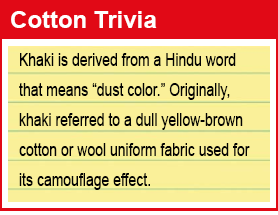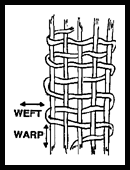The Story of Cotton – Cotton Lint
Textile mills purchase cotton and receive the bales from gin yards or cotton warehouses. These mills start with raw bales of cotton and process them in stages until they produce yarn (fibers twisted into threads used in weaving or knitting) or cloth (fabric or material constructed from weaving or knitting).
The first stage is in the opening room. Here, bales are opened and laid in a line on the floor, side by side, near a cotton opening machine. This machine travels along the line of opened bales, pulling fibers to be sent to a mixing machine and then on to the carding system.
 Carding is the process of pulling the fibers into parallel alignment to form a thin web. High speed electronic equipment with wire toothed rollers perform this task. The web of fibers is eventually condensed into a continuous, untwisted, rope-like strand called a sliver, (pronounced slyver).
Carding is the process of pulling the fibers into parallel alignment to form a thin web. High speed electronic equipment with wire toothed rollers perform this task. The web of fibers is eventually condensed into a continuous, untwisted, rope-like strand called a sliver, (pronounced slyver).
These slivers then continue to a combing machine. Here, the fibers shorter than half-inch and impurities are removed from the cotton.
This process makes the sliver smoother so more uniform yarns can be produced. The drawing or pulling of this sliver is next.
The sliver is drawn out to a thinner strand and given a slight twist to improve strength, then wound on bobbins (spools wound with the thread-like product for storage). Having completed this process, it is now called roving. The roving bobbins are now ready for the spinning process.
Spinning is the last process in yarn manufacturing. Today’s mills draw and twist the roving into yarn and place it on bobbins. They do this quite efficiently. A large, modern mill can produce enough yarn or thread in 30 days to wrap around the earth 2300 times or go to and return from the moon 235 times. With the use of automatic winding, the yarn bobbins are transferred to larger bobbins called cheese cones. These cheese cones can be stored until they are needed in the weaving process.
 The weaving process uses yarn that, depending on how it lies in the woven goods, now assume different names. These yarns may now be either a warp or a weft yarn. Warp refers to yarns that run lengthwise in woven goods. In preparation of warp yarns for weaving, hundreds of yarn strands are wound from cheese cones onto a large warp beam. Yarns on this beam are then coated with a sizing compound (a starch mixture) to add strength for weaving. The sized yarns are then wound onto a loom beam that will be placed on the loom (a machine used to interlace yarns to form cloth). Weft is the yarn that runs crosswise in woven goods and may be referred to as filling yarn. Sizing is not placed on weft because flexibility is needed in the weaving process. In today’s most modern mills, the weft is fed into the loom from cheese cones with air-jets at such a high speed that its movement cannot be seen.
The weaving process uses yarn that, depending on how it lies in the woven goods, now assume different names. These yarns may now be either a warp or a weft yarn. Warp refers to yarns that run lengthwise in woven goods. In preparation of warp yarns for weaving, hundreds of yarn strands are wound from cheese cones onto a large warp beam. Yarns on this beam are then coated with a sizing compound (a starch mixture) to add strength for weaving. The sized yarns are then wound onto a loom beam that will be placed on the loom (a machine used to interlace yarns to form cloth). Weft is the yarn that runs crosswise in woven goods and may be referred to as filling yarn. Sizing is not placed on weft because flexibility is needed in the weaving process. In today’s most modern mills, the weft is fed into the loom from cheese cones with air-jets at such a high speed that its movement cannot be seen.
The woven cloth from the loom, called greige or grey, is whitish but has a natural yellow tint. This cloth is further treated by various means to improve its appearance and feel, then either bleached, dyed or printed to produce the fabrics used in various products seen on store shelves.
There are three basic weaves that are used. The plain weave, the most common, is produced by passing the weft yarn over and under each warp yarn, alternating each row. This is used for cotton print cloth, sheeting, muslin and more. The twill weave is produced by interlacing yarns in an angle to form straight, diagonal ridges across the fabric. This is used for sturdy products such as denim, gabardine and ticking. The satin weave, has a surface that consists mostly of warp yarn which is passed over and under all but one weft yarn that intersects in a regular or irregular formation, not a straight line. This weave produces a fabric with a smooth surface. It is used for upholstery, home decorating and fashionable apparel.
Knitting is another method of turning yarn into fabric. Knit fabric is constructed of yarns made into loops (stitches) which are linked together by the use of needles. There are two basic types of knitted fabric. The weft knit fabrics are made with yarns forming loops the width of the fabric on a circular machine, producing jersey knit used in T-shirts and underwear. The warp knit fabrics are produced by feeding yarns to form loops in a lengthwise direction and are used for tricot fabrics and cotton lace. Knitted fabrics are softer and more flexible than woven fabrics. Making them ideal for sweaters, active sportswear and hosiery.
 We have done all the research for you…gathered supplemental literature books, videos and CD’s, and offer a variety of resources to be used in conjunction with your study unit. So let’s get started on our cotton’s journey and learn more about this useful, resourceful and magical plant we take for granted…COTTON!
We have done all the research for you…gathered supplemental literature books, videos and CD’s, and offer a variety of resources to be used in conjunction with your study unit. So let’s get started on our cotton’s journey and learn more about this useful, resourceful and magical plant we take for granted…COTTON! ![]()

